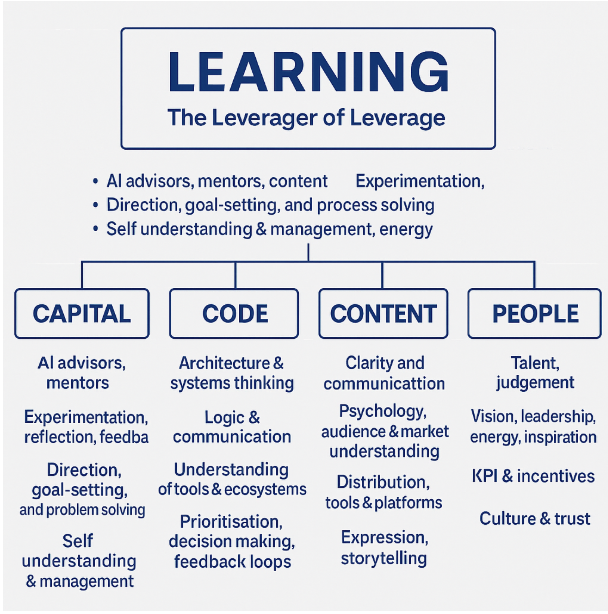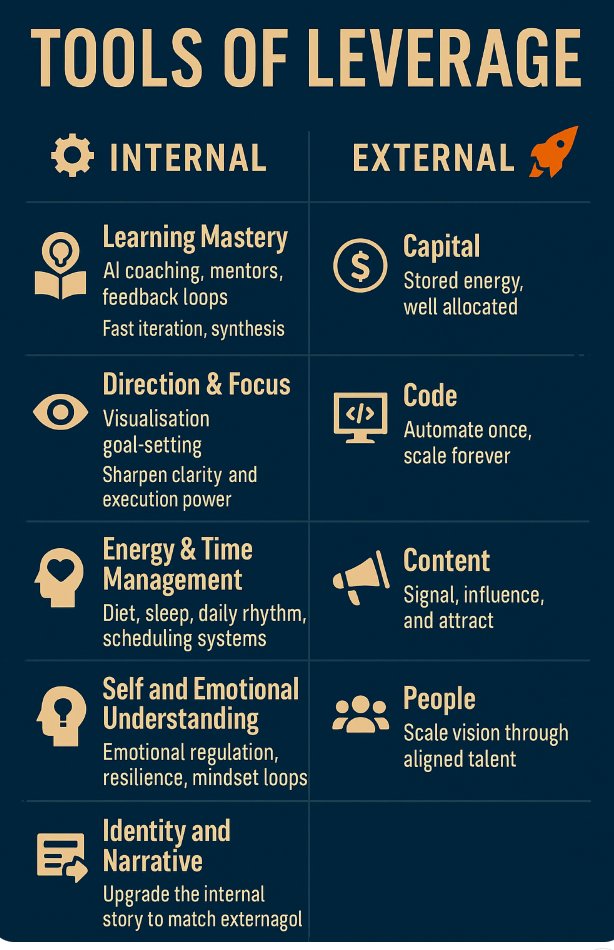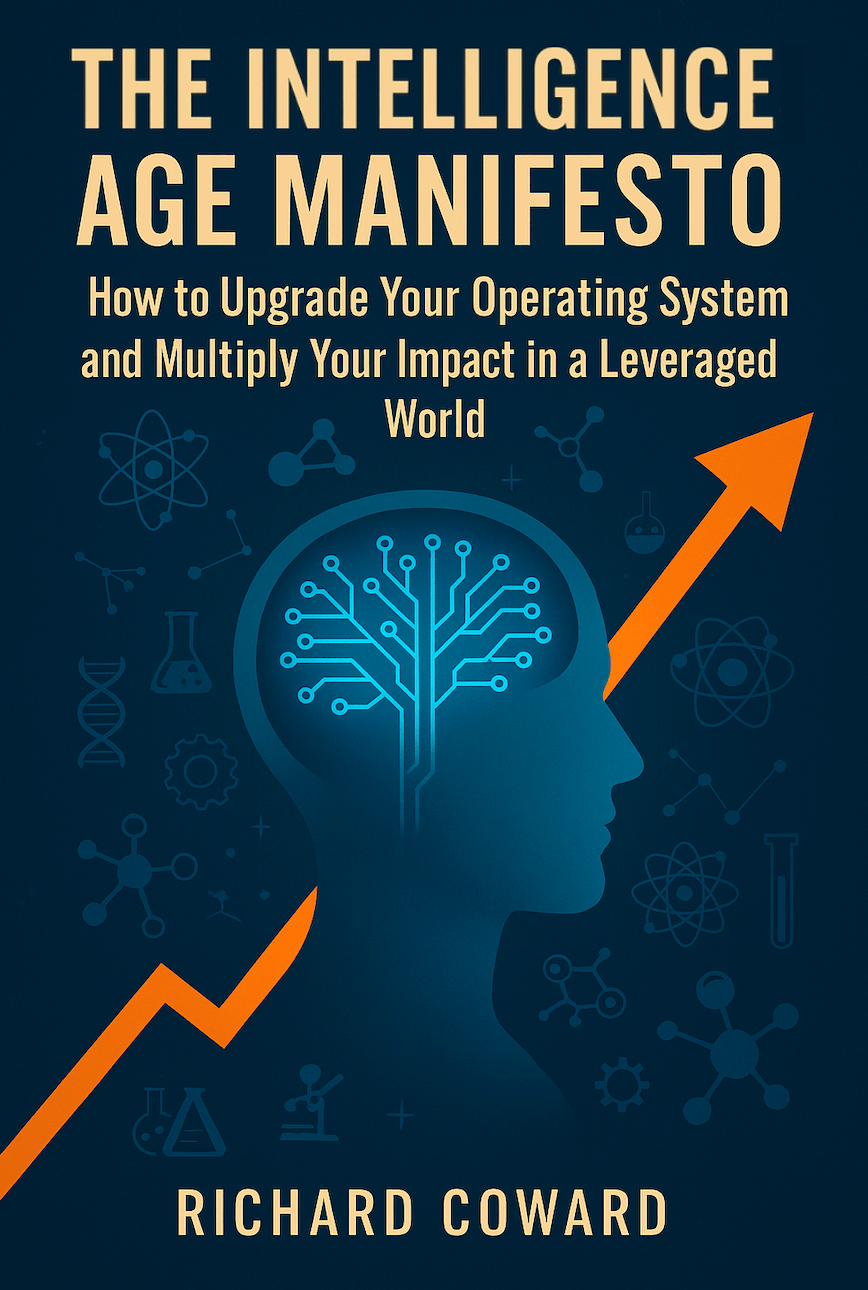🔁 “We must upgrade our operating system.”
That is the philosophy of the Intelligence Age.
It’s true on multiple levels:
| Layer | What It Means |
| Personal | Rewire how you think, act, and perceive — shift from effort to leverage. |
| Organizational | Redesign teams, tools, incentives — optimize for compounding, not control. |
| Civilizational | Build societies around creativity, autonomy, and exponential systems — not industrial models. |
🧬 The Self is a System
- You are not a fixed identity. You are a living system.
- You can refactor yourself like code — your inputs (learning), logic (mental models), and outputs (actions) are all programmable.
The Intelligence Age Manifesto
How to Multiply Output, Master Modern Power, and Win in the Age of Disruption
Today, it’s necessary to properly understand, direct, apply and use leverage.
We are living in an era of exponential tools, compounding systems, and infinite distribution. The game has changed, because the rate of change has accelerated — not just how much you can do, but how far your ideas, capital, code, and influence can reach.
Effort alone is no longer enough.
To thrive in the modern world, you must build a leverage stack.
If you are not using leverage in a leveraged world, you are being outcompeted — and underliving your potential.
This is the map.

Learning: The Leverager of Leverage
Learning is no longer a passive pursuit. It is the core operating system for everything else. The speed and depth at which you learn determines the ceiling of your potential.
In the age of AI and infinite information, how you learn is more important than what you know.
To master learning:
- Set clear direction, goals, and problems to solve — learning thrives under aim.
- Cultivate self-understanding, energy, and inner management — your system must be stable to evolve.
- Use AI advisors, mentors, and content as exponential inputs.
- Embrace experimentation, reflection, and feedback as your growth engine.
Learning is not a task.
It is the meta-skill that multiplies the following.
Capital: Stored Energy, Directed Wisely
Most people misallocate money, hoard it, or fear it. Money is stored potential.
To master capital:
- Cultivate logical judgment about where to allocate resources.
- Build real financial literacy — budgeting, forecasting, and cash flow mastery.
- Understand risk deeply — not to avoid it, but to price it accurately.
- Practice capital allocation — placing bets where the upside outweighs the downside.
Capital becomes power when it’s allocated with vision.
Capital becomes dangerous and wasted potential when it’s unmanaged.
Learn to see money not as wealth, but as fuel.
Code: Infinite Replication at Zero Marginal Cost
Code is pure leverage. It lets you build once and execute forever. It automates, integrates, and scales ideas and tasks with unmatched efficiency.
To master code:
- Think in architecture and systems — write for scale, not one-time use.
- Understand tools, stacks, and ecosystems — what you build on shapes how you build.
- Train your logic and communication — code is read more than it’s written.
- Apply prioritisation, decision-making, and feedback loops — great code is iterative and lean.
You don’t need to be a full-time programmer.
But if you can think in code, you can design machines that work while you sleep.
Content: Scaled Identity, Reputation, and Influence
Content is the most underestimated form of modern power.
It is your thoughts, your story, your value — at scale.
To master content:
- Aim for clarity and precision — be understood, not just heard.
- Study psychology, markets, and audience behavior — relevance beats creativity.
- Learn the tools and platforms of distribution — virality is algorithmic.
- Master expression and storytelling — it’s not what you say, it’s how it lands.
Content is not “just marketing.”
It is the digital artifact of who you are — and a magnet for those you’re meant to lead.
People: The Original Exponential Force
People are not resources. They are multipliers.
A single aligned, high-talent individual can 10x, 100x, or 1000x your output — if you learn to lead.
To master people:
- Develop talent judgment — know who to bet on, and when to let go.
- Cast a bold vision, lead with energy, and inspire with purpose.
- Design smart incentives and KPIs — what gets measured and rewarded, gets done.
- Build culture and trust — not through perks, but through truth, care, and high standards.
People don’t follow tasks.
They follow frequency.
If you resonate powerfully, you attract those who can build with you.
You have to use leverage in a leveraged world
Leverage creates asymmetry
- One person with code can serve 10 million users.
- One person with content can reach a global audience.
- One person with capital can multiply effort without lifting a finger.
- One person with people can scale output 100x.
Meanwhile, someone selling baskets on their street trades time for dollars. It may be honest, but it’s bounded — by geography, energy, and time.
But can’t you just get excellent in one field?
Yes, Mastery in One Area Still Works
- A top-tier lawyer can earn millions.
- A world-class singer can reach global audiences.
- A killer salesperson can close huge deals.
BUT… look closer:
The lawyer who builds a firm and trains juniors scales through people.
The singer who owns their masters and builds a brand uses content + capital.
The salesperson who trains others or builds funnels uses systems + code + content.
In every case, they eventually tap into leverage — whether by intent or necessity.
the leverage gap
The leverage gap is the difference between what you could be achieving if you used leverage, and what are currently achieving without leverage.
It’s the difference between someone who makes baskets and sells them on the side of the road compared to someone who
External Leverage
People Leverage – Hires people to make baskets for them and sells them on the side of the road
Code & Content – Sells them online on an online shop to people all over the world
Content – does live streaming demonstrations of the basket
Capital – gets fundraising to improve the product to reinvest
Internal Leverage
These are even more important, because they determine whether external leverage is recognized, used, or wasted.
| Internal Tool | Leverage Gap = Difference between… | Bottleneck Example |
|---|---|---|
| Learning | What you could know vs what you do | Doesn’t know about AI, misses massive opportunity |
| Direction | Aimed action vs unfocused motion | Talented but scattered across 5 projects |
| Energy | Energized, high-output self vs depleted self | Knows what to do, but feels burned out |
| Judgment | Smart bets vs poor allocation | Builds wrong product, wrong market |
| Identity | Empowered narrative vs limiting story | “I’m just a lawyer” → instead of builder, leader, investor |
In a world of infinite leverage, the leverage gap is infinite — but the next step is finite.
The gains for each individual tool of leverage is not infinite, and can be measured to assess the bottleneck, and what to focus on next, which provides a map of which tools to access and focus on next.
So what’s the real shift in the Intelligence Age?
It’s this:
You don’t need to grind forever in one skill.
You can layer leverage to amplify results — faster, with less burnout.
So while being a world-class lawyer can work, becoming a lawyer who also builds:
- A content brand (thought leadership)
- An AI-powered firm (code)
- A client acquisition system (content + people)
- A fund or syndicate (capital)
…is how you 10x or 100x your impact and wealth.
You can be an elite lawyer or footballer but if you don’t understand leverage you’re not reaching your greatest potential.
Applying or Combining Leverage
You must understand all of them.
- Each lever is part of the modern landscape — whether you choose to use it directly or not.
- Understanding how each lever works gives you:
- Better judgment
- Better collaboration
- Better positioning
You don’t need to master code, but you must understand how engineers think.
You don’t need to run a fund, but you must know how capital moves.
This cross-domain literacy is the new baseline.
You only need to master one.
- Leverage rewards sharp edges. Mastery in one domain gives you unfair advantage.
- Mastery creates identity — “the coder,” “the capital allocator,” “the storyteller,” “the recruiter.”
- The world rewards specialists who collaborate — not generalists who dabble.
Be world-class in one lever, fluent in the rest.
Your greatest results come from orchestrating them.
- Power comes not from isolated use, but interplay:
- Learning feeds all other levers.
- Code automates People ops.
- People helps you scale content, and
- Content attracts People and Capital.
- Capital hires Code and amplifies Content.
Think of yourself as a conductor — not just an operator.
The more you integrate, the more exponential the result.
Build a leverage flywheel loop
You can build a leverage flywheel loop that compounds over time.
Your own loop will be depend on your skillset, interest, goals, industry and mroe.
For example
→ Learning sharpens judgment
→ which improves Capital allocation
→ which funds scalable Code systems
→ which automates and amplifies Content
→ which attracts aligned People
→ who push you to further Learn and evolve
→ and the loop spins faster, compounding output, impact, and wealth
You’re no longer just working harder — your system is compounding.
- Every blog post attracts more leads
- Every team member multiplies output
- Every line of code saves hours
- Every insight sharpens the next decision
This is exponential growth, not linear grind.
Understanding Your Natural Strengths & Constraints
For most people, they have a leverage constraint and a leverage strength.
The constraint is what is stopping them from growing and using leverage, for example – if a lawyer is running out of time, their constraint is their time, and their ability to hire and train other people, or use code to automate some parts.
The natural strength, is whatever you are best at, and should double down on. People usually have a natural strength that they are most interested in, or naturally best at, that complements their skills. If you are empathetic and can understand people, then you would be better to focus on people, and or content, and develop that as a strength.
If you are a systems thinker, then code, might be your advantage, or if you like analysing data, then finance, or content might be the strength to focus on. The key is to match up the leverage with your strengths.
Common Leverage Archetypes
| Archetype | Core Lever | Strength | Shadow | Mastery Path |
|---|---|---|---|---|
| The Architect | Code / Systems | Systems thinking, product design, automation | Over-engineering, isolation | Learn distribution, user empathy |
| The Magnet | Content | Charisma, storytelling, attraction | Vanity, inconsistency | Build systems + teams to scale reach |
| The Alchemist | Capital | Capital allocation, investing, strategy | Greed, analysis paralysis | Master judgment, ethics, and talent |
| The Operator | People | Leadership, operations, team design | Control, burnout | Delegate with clarity, build systems |
| The Seeker | Learning | Rapid learner, synthesizer, explorer | Idea addiction, indecision | Apply knowledge, pick a direction |
| The Messenger | Narrative / Truth | Vision, philosophy, cultural shift | Detachment, abstraction | Connect ideas to practical tools |
| The Founder | Multiplier | Synthesizes all levers to build new paradigms | Burnout, spread too thin | Replace self with scalable systems |
Common Traps that Block Leverage
| Trap | Description | Antidote |
|---|---|---|
| Effort Worship | Mistaking hard work for progress | Track outputs, not inputs |
| Micromanagement | Doing instead of designing systems | Delegate outcomes, not tasks |
| Lone Wolf Syndrome | Avoiding collaboration | Build with aligned, skilled people |
| Fear of Tools | Avoiding tech, AI, or money | Learn “just enough” to direct them |
| Short-Term Urgency | Always reacting, never designing | Create time blocks for leverage-building |
| Misaligned Identity | “I’m not that kind of person” | Evolve your internal story |
| Unclear Direction | No vision, just motion | Clarify the mountain you’re climbing |
| Information Hoarding | Learning but not applying | Build, test, launch — iterate from output |
Upgrading the Education System
📚 The Old Education taught:
-
Obedience
-
Facts
-
Exams
🧠 The New Education must teach:
-
Meta-skills (Learning, Leverage, Taste, Judgment)
-
Systems thinking
-
Tool fluency (AI, capital, content, code)
-
Self-understanding
✅ How to Win in the Intelligence Age
-
⬜ Identify your leverage strength, bottleneck and archetype
-
⬜ Build your internal tools (energy, clarity, narrative)
-
⬜ Master one external lever, learn the rest
-
⬜ Use AI + systems to multiply output
-
⬜ Build a flywheel that compounds
Conclusion: The New Operating Model
This is not about working more.
It’s about building systems that compound while you rest.
To operate at your highest level in the digital age:
- Learn to upgrade all your levers.
- Master Capital to fuel bets and extend reach.
- Master Code to automate and replicate.
- Master Content to broadcast who you are and attract who you need.
- Work with People to scale beyond yourself.
If others are using leverage, and you’re not, you are not just falling behind — you are leaving lives unimpacted, value unexpressed, and potential unrealized.
That’s the cost.
The future belongs to those who build leverage.
Not later.
Now.
Civilisation Lense
📈 Historical Empires That Rose with Leverage
| Empire | Leverage Stack | Outcome |
| Roman Empire | Roads (infrastructure), bureaucracy (people ops), law (codified systems), military hierarchy (scalable command) | Dominated Europe for centuries |
| British Empire | Naval technology (code), financial instruments (capital), colonial administration (people), printing press & propaganda (content) | Controlled 25% of world by landmass |
| Mongol Empire | Fast horseback warfare (code of war), decentralized generals (people), postal relays (communications), reputation of terror (content) | Fastest-growing empire in history |
| United States | Capital markets (Wall Street), Hollywood + Silicon Valley (content/code), elite universities (learning), global alliances (people) | Global superpower post-WW2 |
| Modern China | Centralized political control (people), infrastructure leverage (capital allocation), mass industrialization (code-like systems), social harmony narrative (content) | Rapid ascent to superpower status |

Internal Tools of Leverage

Before you wield external power, you must master the internal. These tools determine your ability to direct, apply, and sustain leverage:
- Learning Mastery
- AI coaching, mentors, feedback loops
- Fast iteration, synthesis, and direction
- Direction, Focus, Visualisation, Goal-setting
- Sharpen clarity and execution power
- Energy & Time Management
- Diet, sleep, daily rhythm, scheduling systems
- Self and Emotional Understanding
- Emotional regulation, resilience, mindset loops
- Identity and Narrative
- Upgrade the internal story to match external goals
These are your internal compounding engines. They enable external mastery.
These tools don’t work in isolation — they form a stacked loop:
Clarity → Identity → Energy → Learning → Judgment → Output → Feedback → Clarity
Meta-Leverage vs Primary Leverage
| Internal Tools | External Levers |
|---|---|
| Direction, energy, judgment, learning, identity | Code, capital, content, people, products |
External tools are what fire it.
